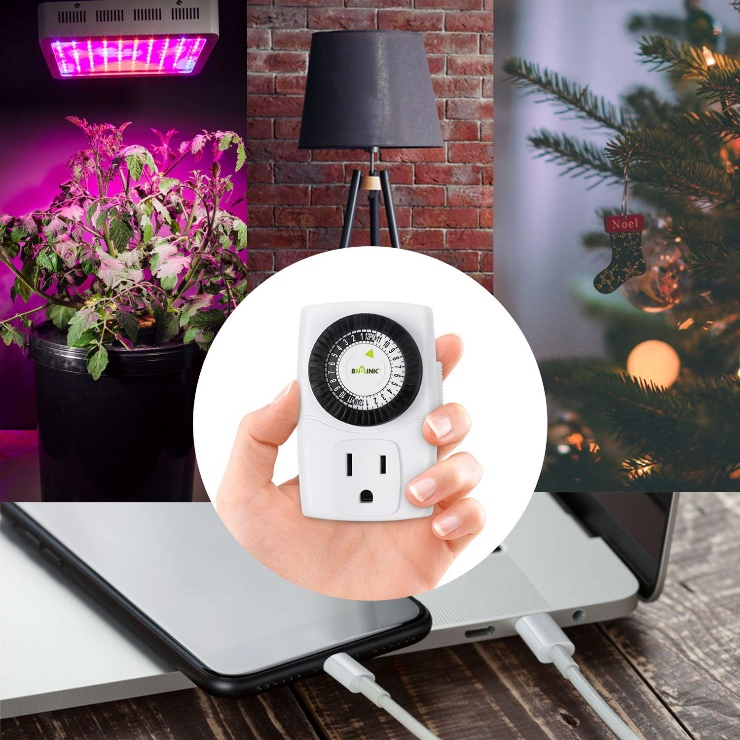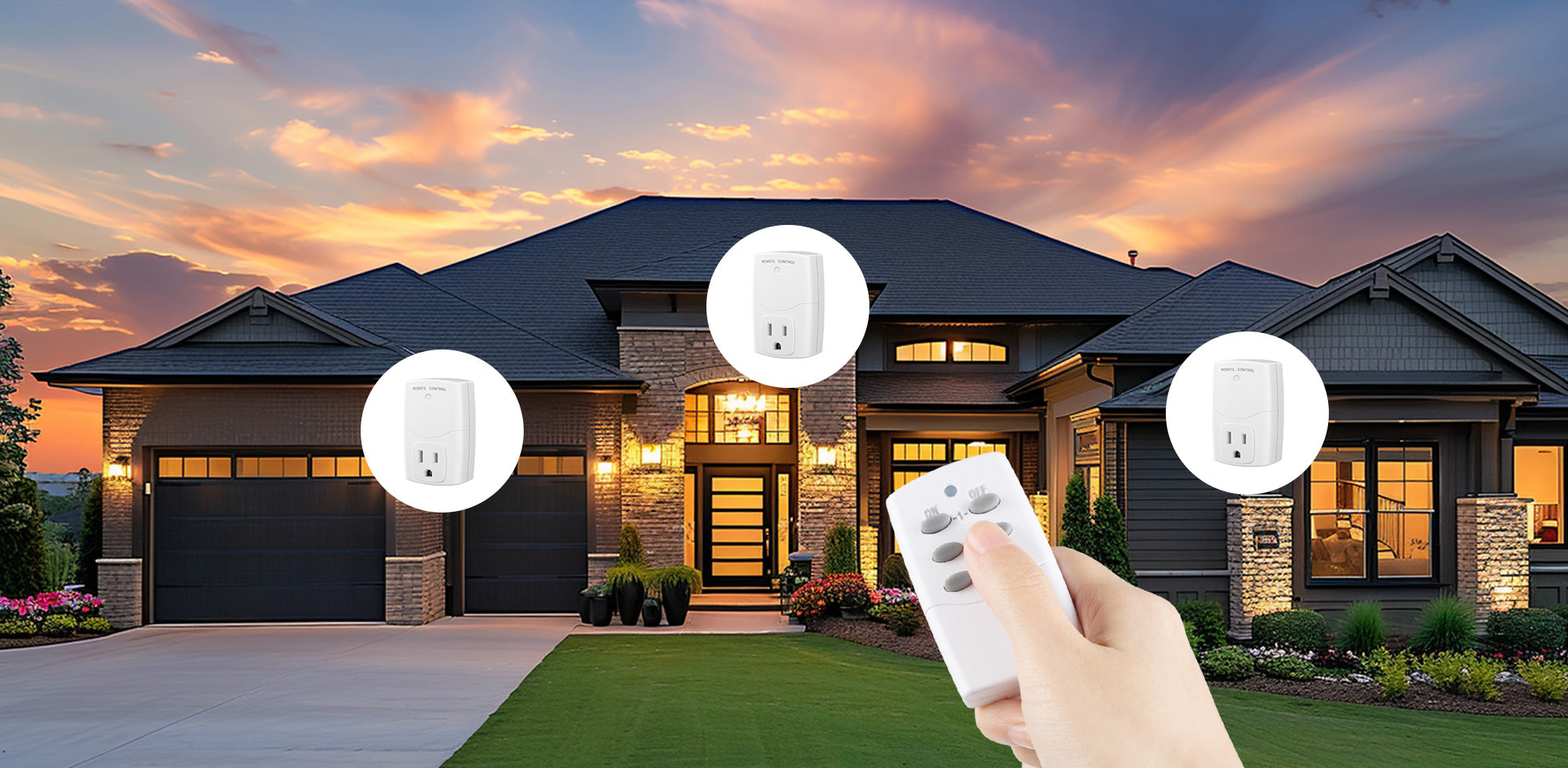Wait! Have I turned off the charger before leaving?
Well, I remember I was about to be late for work and had to manage everything in 10 minutes. My laptop and iPad were still charged, even though they had been charged for the whole night.
Throughout the day, the fact that you have not unplugged the charger could bother you. The fear of a potential explosion might linger in your mind, ruining your day, not to mention the money you could have saved.
Gosh! I shouldn't have relied on my tired brain and should have entrusted control to technology, such as the mechanical time switch. After all, it is the 21st century; technology is the new brainy. To avoid this tragedy, plug-in programmable timers really are the great helpers.

Understanding Mechanical Timer Switch
Timer switches have gradually entered residential and commercial places to facilitate time-sensitive stuff, better safeguard security, and save money by any pennies from the careless allowance of electricity wasting.
What Is a Timer Switch
A mechanical timer switch is a device used to control the timing of electrical appliances or systems.
These timer switches typically consist of a dial or multiple dials with markings representing time intervals, such as minutes or hours. We can rotate the dial to select the desired duration. As time passes, the mechanical components within the switch gradually advance, and when the set time elapses, the switch triggers the connected appliance or system to turn off.
Timer switches generally have two different categories:
Plug-In Mechanical Timer
A plug-in mechanical timer switch is engineered to directly interface with power outlets, offering a straightforward design typically comprised of a white plastic casing with a front-facing knob. Turn the knob clockwise until reaching the desired time duration.
This plug-in timer presents an ideal solution for individuals who prefer not to undertake permanent wall installations or invest in costly timers. Additionally, its portability allows for convenient relocation between outlets, making it suitable for managing multiple appliances with ease.
Mechanical Wall Timer Switch:
The mechanical wall timer switch is tailored for installation and integration into existing wiring systems. Distinguished from the plug-in variant, it boasts several advantages, including the ability to establish permanent connections within a system and provide enhanced flexibility in circuit control.
Installation of the mechanical timer involves connecting it to the hot wire (typically black), neutral wire (white or gray), and ground wire (green or bare copper) of the existing circuit. Once installed, setting the timer entails simply adjusting the knob to the desired time setting.
|
Feature |
Plug-In Mechanical Timer |
Mechanical Wall Timer Switch |
|
Design |
White plastic casing with a front-facing knob |
Tailored for integration into existing wiring systems |
|
Operation |
Turn the knob clockwise to set the desired time duration |
Adjust the knob to the desired time setting after installation |
|
Installation |
Plugs directly into power outlets |
Requires connection to hot wire, neutral wire, and ground wire |
|
Portability |
Portable and can be relocated between outlets |
Fixed installation within existing wiring systems |
|
Advantages |
Simple setup, no permanent installation needed, easy relocation |
Permanent connections within the system, enhanced circuit control |
|
Ideal for |
Individuals do not want permanent installations or costly timers |
Integration into existing wiring systems for enhanced flexibility |
How Does the Timer Switch Work?
Mechanical timer sockets consist of components like
- AC synchronous motor
- Microswitch, LED indicator light
- Voltage dropping resistor
- Wires, conductive rod
- Conductive socket
- Plastic parts like ratchet
- Protectioncover
- Dial
- Casing
After the AC synchronous motor is powered, it generates magnetic force through electricity, which in turn drives the output gear of the motor to rotate at a fixed speed in a single direction (the rotation speed is only related to the voltage frequency of the power supply).
The output gear is connected to the teeth of the dial, and its torque drives the dial to rotate clockwise. The plastic part ratchet used for mechanical transmission is connected to the teeth of the dial on one end and to the contact point of the micro switch on the other.
When the ratchet triggers the contact point of the micro switch, the output circuit is in an energized state; when the ratchet releases the contact point of the micro switch, the output circuit is off.
The inner circle of the dial, with a dedicated design, ensures smooth cooperation between the ratchet and the contact point, thereby ensuring the circuit is on and off correctly.

How Does Mechanical Timer Switch Help?
Auto shut-off
The countdown timer switch is commonly used in fan and light control. Imagine getting home from work and seeing a light that is already bright for you. Or you can just enjoy the warm bath without waiting for the hot water heaters to finish their jobs.
Most switch timers can work in 10 to 12 hours, which can support a large account of daily activities. However, in complicated scenarios, only sustaining half of a day may not fit the demands. Therefore, some mechanical timer switches can work on a 24-hour basis.
Scheduled on and off
We can schedule the power on or off time for the devices. Tasks like charging and cooking will be easier based on the scheduling time.
Facilitate intermittent powering
For managing humidifiers, heaters, and aquariums, intermittent powering is important. Except for the cliché, like making charging more secure, most importantly, it can save electricity bills.
Setting Multiple On/Off Times
Mechanical timer switches can also support power-on/off times in multiple time intervals, such as 7:00-8:00 in the morning, 12:00-14:00 at noon, 17:00-20:00 in the evening, etc. Additionally, it supports a 24-hour automatic cycle, eliminating the need for repetitive operations.
Where Can We Apply the 24-Hour Mechanical Timers?
Mechanical timer switches feature simplicity, reliability, and ease of use, making them suitable for both residential and commercial applications. The following scenarios are the tip of the iceberg.
Electronics Charging
With electric vehicles, most people charge them in their garages at night after commuting during the day. However, they may not have time to unplug the vehicle after 6-8 hours of charging.
In such cases, a countdown automatic power-off feature would be highly beneficial. Once the set time is reached, the current flow is interrupted, stopping the charging of the electric vehicle. The same principle applies to everyday electronic devices such as smartphones and power banks. Once the charging time is set, the power can be automatically cut off when needed.
Cooking
Timer sockets are not limited to countdown functions; scheduling switches are also available. For instance, after setting it up, you can control the operating time of an electric water heater to ensure hot water is available every evening when you return home.
Similarly, if you need to simmer food for an extended period, you can set the electric slow cooker to turn off at a specific time to prevent it from burning dry.
Garden Caring
Mechanical timer switches are ideal for controlling the operation of garden pumps and humidifiers. By setting the timer, users can automate the watering schedule for plants and maintain optimal humidity levels in greenhouses or indoor gardens.
For example, garden pumps can be scheduled to water plants at specific intervals during the day, ensuring consistent moisture levels for plant growth. Similarly, humidifiers can be programmed to operate intermittently, preventing over-humidification while providing adequate moisture for plant health.
Ambient Lights Controlling
Mechanical timer switches offer an easy and efficient way to control ambient lights in gardens or outdoor areas. By setting timers, users can automate the turning on and off of outdoor lights, enhancing the ambiance of outdoor spaces while conserving energy.
Timer switches can be programmed to turn on garden lights at dusk and turn them off at a predetermined time, providing illumination during the evening hours without the need for manual operation. Additionally, timer switches can be used to create lighting effects for special occasions or events, such as outdoor parties or gatherings.
Removing Formaldehyde - Timed Use of Industrial Fans for Ventilation
We can also innovate the use of timer sockets to meet other needs. Ventilation is the most convenient and practical method for removing formaldehyde indoors.
While household fans have relatively low airflow, industrial fans provide sufficient power. However, running them for extended periods, especially when unattended, can be inconvenient. Industrial fans typically lack timer functionality. And the timer switch is here to help.
Mechanical Timer Switches from BN-LINK
BN-LINK offers a diverse range of mechanical timer switches tailored to various needs. From robust outdoor timer switches built for heavy-duty tasks to compact 24-hour mechanical outlet timers perfect for indoor settings, we've got you covered. Plus, we have specialized options for smart powering solutions for your yard and pool.
Outdoor Mechanical Timer Switch
|
Feature |
|
|
|
|
|
Timer Settings |
Cycling scheduling in intervals: On: 5sec - 30min Off: between 5sec - 60min |
ON/OFF |
15-minute intervals |
30-minute intervals |
|
Grounded Outlets |
1 |
6 |
2 |
1 |
|
Safety Features |
ETL Listed, Grounded |
Shut-off for imbalance |
ETL Listed |
ETL Listed |
|
Power Rating |
125VAC, 60 Hz, 1875W |
125V, 60Hz, 15A/1875W |
125V, 60Hz, 15A |
125V, 15A, 1875W |
Indoor Mechanical Timer Switch
|
Feature |
|
|
|
|
|
Ease of Use |
Simple |
Turn-Dial Operation |
Built-in Pin Dial |
Built-in Pin Dial |
|
Maximum Timer Setting |
24h |
24h |
12h |
24h |
|
Minimal Timer Settings |
30-minute intervals |
15 min - 12 hours |
15-minute intervals |
15-minute intervals |
|
Schedule Design |
Up to 24 settings/day |
- |
Up to 48 settings/day |
Up to 48 settings/day |
|
Outlets |
1 |
1 |
2 (per timer) |
2 (per timer) |
|
Safety Features |
- |
ETL Listed, UL Conforms |
UL Listed |
3-Prong Grounded Outlet |
For a more detailed manual guide for the mechanical timer switches, you can visit the BN-LINK. We provide a step-by-step guide for all the settings.












